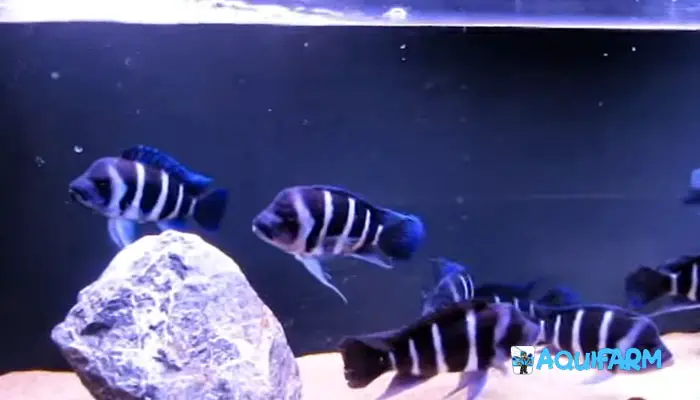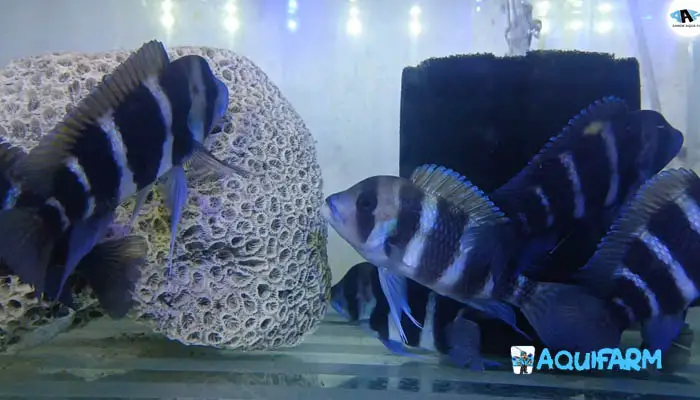Cyphotilapia Gibberosa vs Frontosa: A Detailed Comparison
Both Cyphotilapia Gibberosa and Frontosa belong to the same cichlid family, and both are stunning additions to an aquarium. But one might wonder — how are these two different from each other?
Since they almost look alike, it’s easy to get confused when buying them. For an aspiring aquarist or even an experienced one, the million-dollar question is — Cyphotilapia Gibberosa vs Frontosa: which one should you choose?
I’ve been keeping both species for years now. In this article, I’ll share what I’ve learned about these two so you can make an informed decision when choosing one for your aquarium.
So, let’s explore their differences in detail —
Cyphotilapia Gibberosa vs Frontosa: Which One Is Best?
We can’t just rely on looks, right? We need to think about their temperament, feeding habits, adult size, required environment, and compatibility with other fish.
So, before choosing between Cyphotilapia Gibberosa and Frontosa, let’s go through their features first.
| Features | Cyphotilapia Gibberosa | Cyphotilapia Frontosa |
| Common Names |
|
|
| Origin | Lake Tanganyika, East Africa | Lake Tanganyika, East Africa |
| Family | Cichlid | Cichlid |
| Color and Looks |
|
|
| Nature |
|
|
| Food Habit |
|
|
| Required Environment |
|
|
| Average Size; Breeding |
|
|
| Lifespan | 5–8 years | 15+ years |
| Average Price | $40–$50 (approx.) | $30–$40 (approx.) |
Now let’s go through these characteristics in detail to understand their differences more clearly.
Cyphotilapia Gibberosa vs Frontosa: In Detail
Both fish belong to the same genus Cyphotilapia and the same family, Cichlidae. However, they are different species. Due to their similarity, the Cyphotilapia Gibberosa is sometimes called the Blue Zaire Frontosa or even the cousin fish of Frontosa.
Although similar in appearance, they slightly differ in size, lifespan, temperament, and coloration.
Common Names
Cyphotilapia Gibberosa
Common names include:
- Cichlid Gibberosa
- Frontosa Blue Zaire
- Mpimbwe Blue Frontosa Cichlid
They’re more blue in tone compared to Frontosa, hence often referred to as “Blue Zaire Frontosa.”
Cyphotilapia Frontosa
Because of their distinct head hump, Frontosa are commonly called:
- Humphead Cichlid
- Front Cichlid
- Frontosa Cichlid
Origin
Both species are native to Lake Tanganyika in East Africa, one of the oldest and deepest freshwater lakes in the world. Interestingly, Cyphotilapia Gibberosa was discovered nearly 100 years after Frontosa, indicating they evolved separately within different lake regions and depths.
Color and Looks
Cyphotilapia Gibberosa

Cyphotilapia Gibberosa has deep blue or purplish tones with more distinct stripes. They usually display six or seven vertical bars, and males often show a stronger blue hue.
Cyphotilapia Frontosa

Frontosa are blue-gray or white with fewer dark stripes (usually five or six). Their trademark hump gives them a regal and unique look, especially in mature males.
Nature
Both are relatively peaceful for large African cichlids but may show territorial behavior during breeding.
Cyphotilapia Gibberosa
Generally peaceful among similar-sized cichlids but may prey on smaller fish. They prefer calm tankmates and are best kept in small groups of their own species.
Cyphotilapia Frontosa
Frontosa are calmer and slightly less aggressive than Gibberosa. They coexist well with Synodontis catfish, Peacock cichlids, and Clown loaches when given enough space and hiding spots.
Food Habits
Cyphotilapia Gibberosa
Mainly carnivorous — feeds on shrimp, bloodworms, and small crustaceans. Occasionally nibbles on plants, acting partially omnivorous.
Cyphotilapia Frontosa
Primarily piscivorous — they prefer small fish, krill, prawns, and earthworms. In aquariums, they thrive on high-protein pellets and frozen seafood blends.
Required Environment
Both species thrive in deep freshwater with rocky caves mimicking Lake Tanganyika’s environment. Always maintain stable temperature and pH using quality filtration and aeration systems.
Cyphotilapia Gibberosa
Tank size: minimum 55 gallons (208–210 L). Water type: freshwater with pH 7.5–8.0 and temperature 70–80°F. Add caves and flat rocks to mimic natural shelters.
Cyphotilapia Frontosa
Tank size: minimum 75 gallons (283–285 L). Water type: freshwater, pH 7.8–8.2, temperature 72–82°F. Use rocky structures and sand substrate for comfort.
Average Size and Breeding
Lifespan
Cyphotilapia Gibberosa lives around 5–8 years, while Frontosa can live 15 years or more with proper care and diet.
Average Price
Cyphotilapia Gibberosa typically costs $40–$50, while Frontosa is slightly cheaper at $30–$40 depending on size, coloration, and origin.
Final Verdict
Cyphotilapia Gibberosa stands out for its intense blue coloration, making it a favorite among aquarists who love vibrant tanks. However, Frontosa wins in lifespan, calm temperament, and affordability — making it perfect for long-term aquariums.
The best part? Since both belong to the same genus, they can coexist peacefully in one large, well-maintained tank if you provide enough space and hiding areas.
FAQs
Which Frontosa Is the Most Blue in Color?
What Are the Different Types of Frontosa?
Do Frontosa Like Rocks?
Wrapping Up
Both Gibberosa and Frontosa share many similarities. Hopefully, this article helped you see how they differ so you can make a confident choice.
If you love deep blue tones, go for Gibberosa. If you prefer a peaceful, long-living species, choose Frontosa. Or better yet — keep both together in the same tank with the right setup!
I hope this guide cleared up the confusion about Cyphotilapia Gibberosa vs Frontosa.
Cyphotilapia Gibberosa
Average adult size is 22–25.5 cm. Males grow slightly larger (up to 30 cm). They are mouthbrooders, meaning females hold eggs and fry in their mouths until ready to swim freely.
Cyphotilapia Frontosa
Average size ranges from 23–30 cm, with males sometimes reaching 35 cm. They are also mouthbrooders, and their fry develop slowly, requiring stable water conditions.
Lifespan
Cyphotilapia Gibberosa lives around 5–8 years, while Frontosa can live 15 years or more with proper care and diet.
Average Price
Cyphotilapia Gibberosa typically costs $40–$50, while Frontosa is slightly cheaper at $30–$40 depending on size, coloration, and origin.
Final Verdict
Cyphotilapia Gibberosa stands out for its intense blue coloration, making it a favorite among aquarists who love vibrant tanks. However, Frontosa wins in lifespan, calm temperament, and affordability — making it perfect for long-term aquariums.
The best part? Since both belong to the same genus, they can coexist peacefully in one large, well-maintained tank if you provide enough space and hiding areas.
FAQs
Which Frontosa Is the Most Blue in Color?
What Are the Different Types of Frontosa?
Do Frontosa Like Rocks?
Wrapping Up
Both Gibberosa and Frontosa share many similarities. Hopefully, this article helped you see how they differ so you can make a confident choice.
If you love deep blue tones, go for Gibberosa. If you prefer a peaceful, long-living species, choose Frontosa. Or better yet — keep both together in the same tank with the right setup!
I hope this guide cleared up the confusion about Cyphotilapia Gibberosa vs Frontosa.
- Where Do Catfish Like To Hang Out – Unlocking Their Ideal Aquarium - December 23, 2025
- Noise Making Mechanisms In Talking Catfish – Unlocking Their Secret - December 23, 2025
- How To Prevent Algae On Slow Moving Catfish – The Ultimate Guide To A - December 23, 2025
